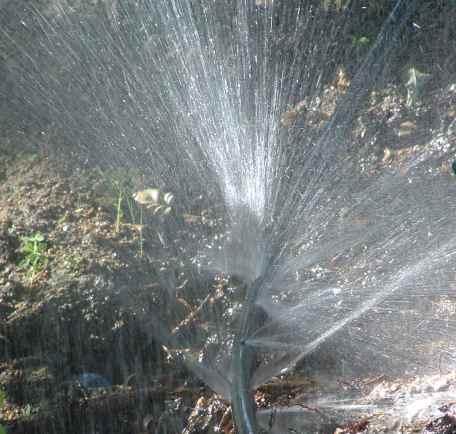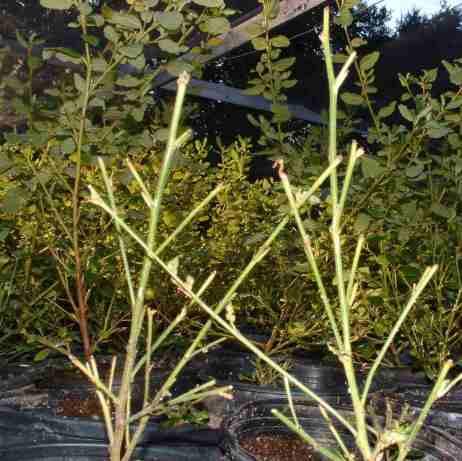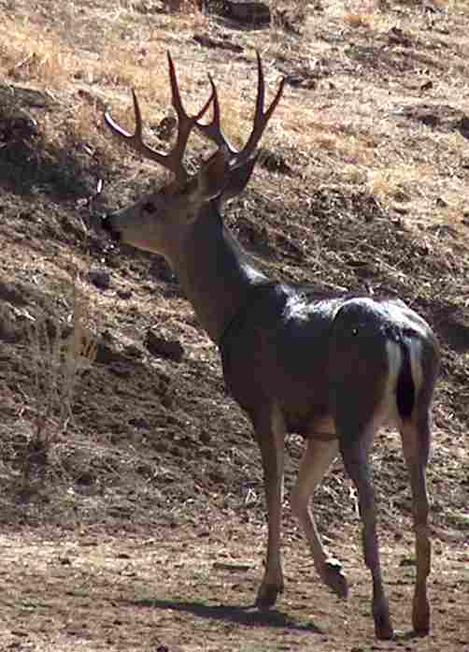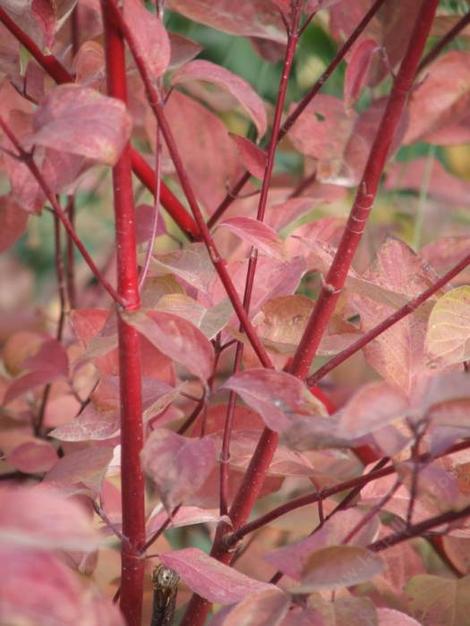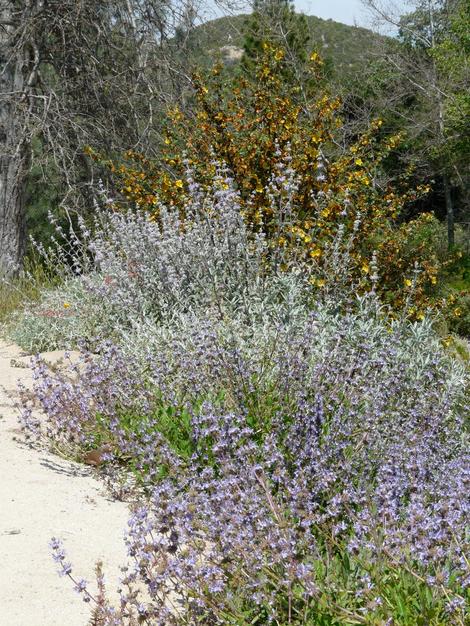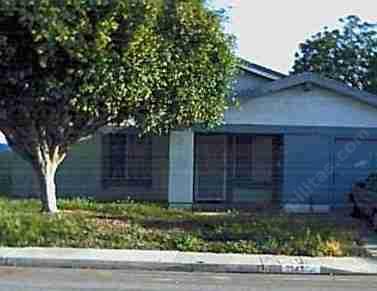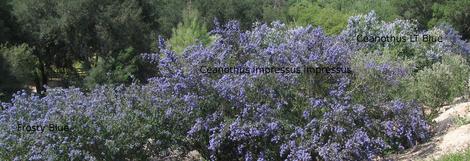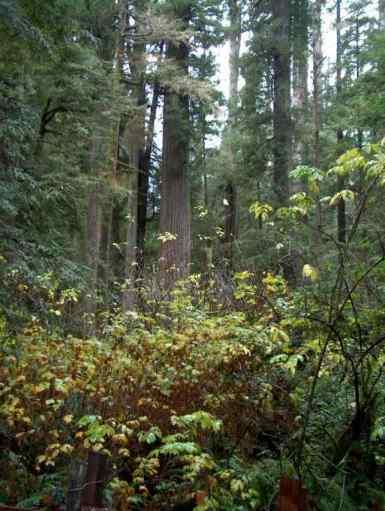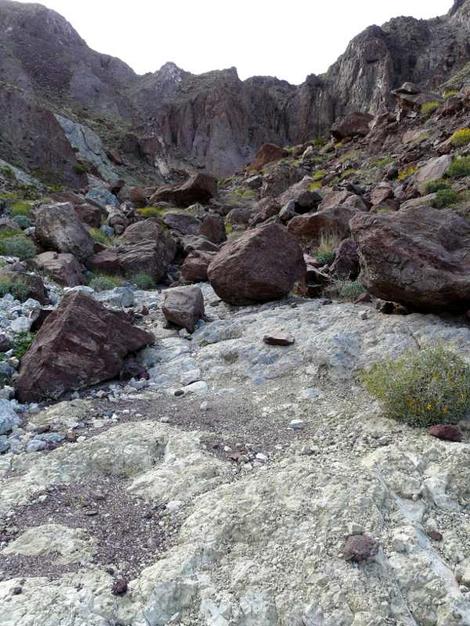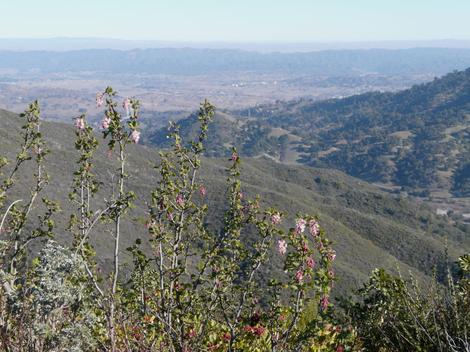Myths about California Native Plants
-
Do not water California native plants with overhead sprinklers.
This myth was started in areas such as the east coast and even, Europe, where the humidity is very high; there, they have warm temperatures combined with summer rainfall which are perfect conditions for the growth and development of many disease organisms (warm and moist). This does not apply very well in most of California, with our Mediterranean climate, with conditions of low humidity and hot summers (warm and dry). Most native plants get their moisture from rainfall, not seeps.
-
Plant California native plants only in the fall.
Early fall can be a problem in areas where the pressure from deer and rabbits and other critters is at its highest point then, when the end of the dry season is near, the animals have run out of food and your newly planted, juicy plants look real tasty! Also, most of California's climate is so mild that you can set out native plants year-round (watch those critters in the fall, though). As landscape contractors that set out plants year-round, guess when we had the highest plant losses? The Fall! By December planting is usually easier and safer. Around Christmas we're planting like mad. Check out the "When to plant native plants page".
-
California native plants look scrawny, scraggly and ratty.
This myth was started from the fact that SOME plants undergo a semi-deciduous period in the summer through fall, to help them survive this dry, warm/hot season of the year. If you can't deal with that, you can minimize it by sprinkling the leaves occasionally, or you can plant EVERGREEN California native plants, such as Toyon, Coffeeberry, Mountain mahogany, Ceanothus, and manzanita, to name a few, which will not go deciduous. Also many native are treated like common garden plants, over watered, over fertilized etc. This stresses them out and they get diseases, die back and just look horrible. They are not petunias so don't treat them like ones! Common California native perennials like Penstemons, Monkey Flowers, can live for 20 or more years, petunias might live for two years, look good for one. What happens if you treat the greenhouse grown stuff like a native plant? (Hint, rhymes with head.) Californians, why would you buy a plant from a box store that came from a greenhouse in Oregon thinking that it's any easier to grow than a native plant grown outdoors from California? One other note, if a native plant looks like it came from a florist, it did. And it will probably look like a florists bouquet after a few days in your yard. Smaller sized gallon plants are usually the safest.
-
California native plants are hard to grow.
This myth probably was started because people tried to grow California native plants just like they grow common garden plants. California native plants are wild plants and they do not grow well under the same conditions as common garden plants. If you had full water rationing what would your 'normal garden' look like.(Rhymes with rugby and head.) Under drought conditions native plants become much easier. Why pay $200/month to water your little lawn, when you can have a green front yard for a few dollars a month? With no gardener? And get some exercise.
-
All California native plants are drought tolerant
This myth probably started because most of California is fairly dry and most people think the dead weeds are native plants. Many California native plants are drought tolerant, but others live in wet, moist areas like ponds, creeks, rivers, marshes, seeps, etc.
-
Drip irrigation is the state-of-the-art for California native plants.
NO. Drip irrigation was developed largely in Israel for vegetable gardens and fruit orchards where the water supply was limited, and applied to crops that are naturally adapted to riparian conditions (creek, pond, marsh, monsoons, get the idea?) or summer rainfall. This type of watering simulates a freshwater marsh. Now, look at the California hillsides! Do those manzanitas, Ceanothus, sagebrush, sages, and buckwheats live in a freshwater marsh?? These upland California native plants grow much better in more natural conditions, using irrigation systems such as overhead watering and/or drip tubing fitted with microspray emitters that deliver the water in a more natural way (ie like rainfall). But even these irrigation systems can be abused and overused. The amount of water you deliver to your plants combined with the time period in which you deliver the water (fall,spring, winter, summer) has a significant effect on whether they will live long healthy lives or short, unhealthy lives. Try not to overwater. We do not have summer ponds on our hillsides. Read the Irrigation page. Ceanothus are alive and look good after 30 years in our garden, if they were on drip they would have died about 25 years ago.
Very Important Note: The anomalies some people are observing are not really anomalies, they just haven't observed for a sufficient time! These people are observing plants in cooler, coastal conditions, or cooler, more northerly conditions. The plant here just dies more slowly but it still dies much sooner than its counterpart that is grown under more natural conditions, without drip irrigation and appropriately watered. . The reason? The organisms that kill many upland California native plants grown with drip irrigation work best under conditions of higher heat and higher moisture, with lower oxygen levels. So this phenomenon of the sick, dying plant occurs more quickly in the hotter, inland, southern areas of California when you add: (1) the moisture concentrated in one spot via drip irrigation, and (2) therefore, lower oxygen levels, and (3) high summer temperatures. For more info check out the drip page.
-
You need to amend the soil when planting California native plants.
Hello? First, amended soils are found naturally in areas disturbed by man or by nature (one example: creeks, rivers, etc. when water rushes down in the spring or summer, or whenever the rainy season occurs, carrying new soil from higher areas, the soil gets churned up by the force of the moving water, and this mixed soil is deposited on the riverbank). Many of our common garden plants come from creekside/riverbank areas such as these, throughout the world. Many California native plants do not! They are adapted to leaf mulch ON TOP OF THE SOIL, not organic matter mixed into the soil next to their roots. Second, current research demonstrates that when you dig a large hole and fill it with amended soil, the plant that you set into the hole has a tendency to just circle its roots around in this amended hole, and grow very few, if any roots, into the surrounding soil. This makes for a very weak, unhealthy plant because it is not growing an extensive root system to support its top growth and it is not getting the benefit of the nutrients in the surrounding soil; its roots are just stuck in the amended hole pretty much until it dies. And we haven't even mentioned the fungal companion that lives with most drought tolerant California native plants, and on which they critically depend for their health and sustenance. This fungal companion HATES amended soil. No till agriculture is being pushed for crops that probably are best adapted to tillage, native plants are best adapted to no till.
"we should recognize that soils are connected to plants almost as integrally as arteries are veins to animals" Hogberg and Read.
We have had irate phone calls and angry emails, where people did not sign their name and fake email addresses, ragging on us about how dare we not advocate drip irrigation and soil amending.
(Most of these have ceased.)
I've personally handled and planted at least a couple of million native plants. I've planted gardens in the Sierras, coast ranges, bluffs, San Joaquin, desert and all parts in between. I'm an analytical chemist that paid for the degree with gardening, then landscaping. Celeste has a Masters in Biology, worked in the nursery, landscaping and done biosurveys through much of the county. Penny has a degree in biology and has worked in the nursery most of her life. After seven years of installations we noticed that we were getting many more call-backs with the drip- irrigated gardens versus the sprinkler irrigated gardens, and many call-backs for a landscape contractor mean the end of your business(or changing the business name and moving). The sprinkler- irrigated gardens had healthier looking plants, and more plants lived, than in the drip-irrigated gardens. We put that together and researched the science of the time. We discovered that the upland California native plants preferred sprinkler irrigation (or microspray emitters, if you like). and not much of that. The only native plants that tolerate or like drip are the rushes and other in wetland plants. Many of our native plant gardens are still going strong, after 30 years, with very few losses (the ones that followed our guidelines). We stopped amending in 1976 and using drip in 1982 or so.
Customers, this is a trade where everyone is an expert and they like your money. Educate yourself, ask questions and talk to people they've worked for. (Preferably a decade of so before.) If there's a trail of dead or ugly landscapes behind them, you can do better than that yourself. We love well-read customers.
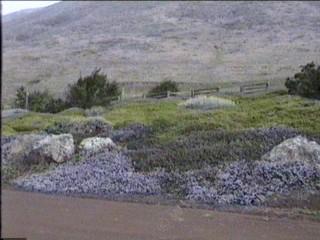
We would like to express our sincere and heartfelt thanks to our loyal customers that have followed our planting guidelines or helped us in figuring out how to make it clearer. We want you to have good results with California native plants.
